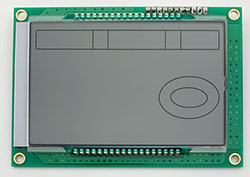Liquid crystal display (LCD) is a very common electronic display in our life. Hearing its name, you may wonder if there is any liquid in it?
There is a special fluid in the LCD display, which is called liquid crystal. Just like its name, liquid crystal has some properties of both liquid and crystal: on the one hand, it can flow like a liquid; On the other hand, the arrangement of molecules is as orderly as that of solid crystals, which can be said to be a state between liquid and solid. By applying different voltages to the liquid crystal layer in the screen, the arrangement of its molecules can be changed and show different optical properties, such as light transmittance. This photoelectric effect is the basic principle of liquid crystal screen imaging.

There are many kinds of liquid crystals, such as biphenyl liquid crystals, phenyl cyclohexane liquid crystals and ester liquid crystals. Traditional display screens such as CRT image tube display (the phosphor on the inner surface of the screen is excited by the electron beam to display images) tend to be large in size, while the LCD screen can be very light and thin, with low voltage and low power consumption, so it is more popular
The 8 inch displays might be affected and delay for an accident.
New iPhone 13 Series will use On-Cell OLED Displays. And it that will be launched in the second half of this year will be exclusively supplied by Samsung Display (SDC)
This is the project management of how sinocrystal handle your customized project relate to displays.
Discover the key factors to consider when choosing an LCD display for your project, including size, resolution, interface, brightness, and customization options from a factory-direct manufacturer.
Discover the latest innovations in rugged LCD displays for harsh environments — from extreme temperature resistance to sunlight readability and waterproof designs. Factory-direct manufacturing with full customization.
A complete guide to LCD display connection methods, including SPI, I2C, RGB, MIPI, LVDS interfaces and physical mounting options. Learn how to connect monochrome and TFT LCDs to your development board or product housing.
This week, we had the pleasure of hosting an esteemed international client at our LCD display manufacturing facility in Dongguan. Guided by our team, the client visited key production areas such as the fully automated COG bonding line, backlight assembly area, full lamination workshop, and final product aging test section. They highly appreciated our production capacity, strict quality control, and engineering expertise. This visit strengthened mutual trust and set the stage for future collabora